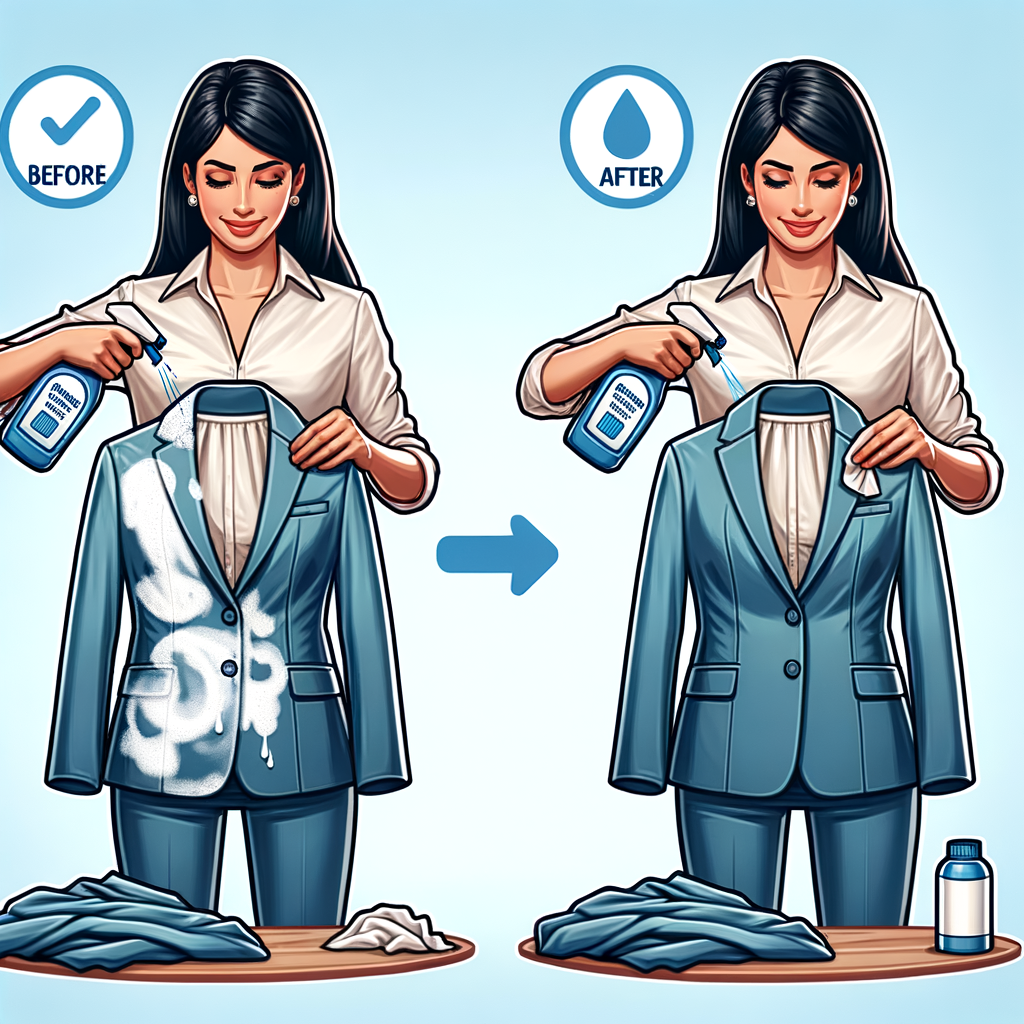
Introduction: The Challenge of Chalk Stain Removal
Chalk stains may seem harmless at first glance, but they can be quite a challenge to remove. This is especially true if the stains have been left untreated for a while. The key to effectively dealing with chalk stains lies in understanding their nature and why they are a common problem.
-
- Understanding the nature of chalk stains
Chalk is made up of fine particles that can easily get embedded into the fibers of your clothes. These particles are not soluble in water, which means that they don’t just wash away like some other types of stains. Instead, they cling to the fabric, creating a stain that can be hard to remove.
-
- Why chalk stains are a common problem
Chalk stains are a common problem because chalk is often used in a variety of settings. It’s used in schools, for sports, and even for home decoration. This widespread use of chalk increases the chances of getting chalk stains on your clothes. Furthermore, because chalk is usually white or light-colored, it can be hard to notice the stains until they have set in.
Dealing with chalk stains can be a daunting task, but it’s not impossible. With the right knowledge and tools, you can effectively remove these stains and keep your clothes looking fresh and clean. In the following sections, we will delve deeper into the science behind chalk stains, and provide a step-by-step guide on how to remove them.
Understanding Chalk Stains: The Science Behind the Stains
When it comes to chalk stains, there’s more than meets the eye. The stubborn marks that chalk leaves on clothing are not just a nuisance; they are a result of fascinating scientific processes. Let’s delve into the science behind chalk stains, and understand why they are so hard to remove.
-
- How chalk interacts with fabric
Chalk, scientifically known as calcium carbonate, is a soft, white substance that easily crumbles and breaks down into fine particles. When chalk comes into contact with fabric, these tiny particles get lodged into the tiny spaces between the fibers of the fabric. This is why when you try to dust off the chalk, it doesn’t completely come off. The chalk particles are stuck in the fabric, creating the stain you see.
-
- Why chalk leaves a mark: the science explained
But why does chalk leave a mark in the first place? The answer lies in its composition. Chalk is made up of tiny crystals, and when it is rubbed against a surface, these crystals break down and spread out, creating a visible mark. This is the same reason why chalk can write on a blackboard. The friction between the chalk and the board causes the chalk to break down and leave a mark. The same process happens when chalk comes into contact with fabric. The friction causes the chalk to break down and leave a mark, which we see as a stain.
In conclusion, the reason chalk stains are so stubborn is because of the way chalk interacts with fabric. The tiny particles of chalk get lodged in the fabric, and the friction causes the chalk to break down and leave a mark. Understanding this science can help us better tackle the problem of chalk stains and find effective solutions for removing them.
Prevention: The First Step to Stain-Free Clothing
Before we dive into the nitty-gritty of stain removal, let’s talk about prevention. After all, the best way to deal with a stain is to never have one in the first place. This section will focus on how to prevent chalk marks on fabric, a common issue that can be avoided with the right approach.
Preventing Chalk Marks on Fabric
Chalk stains can be a real nuisance, especially when they appear on your favorite clothes. But don’t worry, there are ways to prevent these stains from happening. Let’s explore some of them.
-
- How to handle chalk to prevent stains
Handling chalk properly is the first step towards preventing chalk stains. When using chalk, make sure your hands are clean and dry. This reduces the chances of the chalk crumbling and leaving marks on your clothes. Also, avoid rubbing the chalk against the fabric. Instead, use it gently and at a safe distance from your clothes.
-
- Protective measures for avoiding chalk stains
Another effective way to prevent chalk stains is by taking protective measures. For instance, you can wear an apron or a smock when using chalk. This will shield your clothes from any potential chalk marks. If you’re working in a chalky environment, consider covering the surrounding area with a cloth or a sheet to catch any chalk dust. Also, remember to wash your hands thoroughly after using chalk to avoid transferring any residue to your clothes.
Prevention is indeed the first step to stain-free clothing. By handling chalk properly and taking protective measures, you can significantly reduce the chances of getting chalk stains on your clothes. So, the next time you use chalk, keep these tips in mind and enjoy a stain-free experience.
Removing Stains from Clothes: A Step-by-Step Guide
Stains can be a nuisance, but with the right knowledge and tools, they can be easily removed. In this guide, we will focus on chalk stains, which are common but can be tricky to remove if not treated correctly. Here’s a simple step-by-step guide on how to remove chalk stains from your clothes.
How to Remove Chalk Stains: The Basics
Before we dive into the process, it’s important to understand that not all stains are the same. The method of removal can vary depending on the type of stain. In this section, we will cover the basics of removing chalk stains.
-
- Identifying the stain
First, you need to make sure that the stain on your clothes is indeed a chalk stain. Chalk stains usually appear as white or colored powdery marks on the fabric. They are dry and can often be brushed off, but they may leave a residue that needs to be washed out.
-
- Pre-treatment for chalk stains
Before washing the stained clothing, it’s important to pre-treat the stain. Start by brushing off as much of the chalk as possible. Then, apply a small amount of liquid laundry detergent directly to the stain. Gently rub the detergent into the stain with your fingers or a soft brush. Let it sit for at least 15 minutes before washing.
-
- Washing and checking the stain
After pre-treatment, wash the clothing as you normally would, following the care instructions on the label. Use warm water if allowed by the fabric care instructions. After washing, check the stain before drying. If the stain is still there, repeat the pre-treatment and washing process. Drying can set the stain, making it harder to remove.
Remember, patience and persistence are key when dealing with stains. With these steps, you should be able to effectively remove chalk stains from your clothes.
Advanced Techniques for Cleaning Chalk off Clothes
While the basic methods of chalk stain removal can be effective, sometimes you may need to employ more advanced techniques. These techniques involve the use of stain removers and some home remedies that have proven to be quite effective. Let’s explore these methods in detail.
- Using Stain Removers
Stain removers are specially formulated products designed to tackle stubborn stains. They contain ingredients that break down the stain, making it easier to wash away. When dealing with chalk stains, it’s important to choose a stain remover that’s safe for the fabric of your clothes.
Here’s a simple step-by-step guide on how to use stain removers:
- Apply a small amount of the stain remover directly to the chalk stain.
- Let it sit for a few minutes to allow the stain remover to penetrate the stain.
- Using a soft brush or cloth, gently rub the stain remover into the stain.
- Wash the clothing item as you normally would.
- Check the stained area before drying. If the stain is still visible, repeat the process.
- Home Remedies for Chalk Stain Removal
Home remedies can be a cost-effective and convenient alternative to commercial stain removers. They utilize common household items, making them easily accessible. Here are a few home remedies you can try:
- Vinegar: Mix one part white vinegar with three parts water. Apply the solution to the stain and let it sit for a few minutes before washing.
- Baking Soda: Make a paste of baking soda and water. Apply this paste to the stain and let it sit for 15-20 minutes. Rinse and wash as usual.
- Dish Soap: Apply a few drops of dish soap to the stain. Gently rub it in and let it sit for a few minutes before washing.
Remember, always test these remedies on an inconspicuous area of the clothing item first to ensure they won’t damage or discolor the fabric.
By using these advanced techniques, you can effectively clean chalk off your clothes. Whether you choose to use a stain remover or a home remedy, the key is to act quickly and treat the stain as soon as possible to increase your chances of successful removal.
Stain Removal Tips: Making the Process Easier
Removing stains from clothes can sometimes be a daunting task. However, with the right knowledge and techniques, it can be made much easier. Here are some best practices for stain removal and common mistakes to avoid.
- Best practices for stain removal
When it comes to stain removal, there are a few key practices that can make the process more effective:
- Act quickly: The sooner you treat a stain, the better. Fresh stains are easier to remove than old ones.
- Test the fabric: Before applying any stain removal product, test it on a small, hidden area of the garment to ensure it won’t damage the fabric.
- Blot, don’t rub: Rubbing a stain can spread it and push it deeper into the fabric. Instead, blot the stain with a clean cloth to absorb as much as possible.
- Use the right stain remover: Different types of stains require different types of stain removers. For example, protein-based stains like blood and sweat respond well to enzymes, while oil-based stains need a solvent-based remover.
- Rinse from the back: Rinsing the stained area from the back helps to push the stain out of the fabric, rather than deeper into it.
- Common mistakes in removing stains from clothes
While trying to remove stains, people often make some common mistakes that can make the stains even harder to remove:
- Using hot water on protein-based stains: Hot water can set protein-based stains like blood and egg, making them harder to remove. Always use cold water for these types of stains.
- Scrubbing the stain: As mentioned earlier, scrubbing can spread the stain and push it deeper into the fabric. Always blot, don’t scrub.
- Using too much stain remover: More is not always better. Using too much stain remover can leave a residue on the fabric and may even discolor it.
- Not rinsing out the stain remover: Always rinse out the stain remover thoroughly. If left in the fabric, it can attract dirt and cause a new stain.
By following these best practices and avoiding common mistakes, you can make the stain removal process much easier and more effective.
Case Study: Chalk Stain Solutions in Action
Let’s dive into some real-life examples to understand how chalk stain removal works in practice. We’ll also discuss some lessons learned from failed attempts, so you can avoid making the same mistakes.
-
- Real-life examples of successful chalk stain removal
Consider the case of a primary school teacher, Mrs. Johnson. She often found her clothes stained with chalk dust after a day of teaching. She tried a simple solution: applying a mixture of vinegar and water to the stain, then gently rubbing it before washing. To her surprise, the chalk stain disappeared completely!
Then there’s the case of a professional artist, Mr. Smith, who works with chalk pastels. He found that a pre-treatment with a stain remover before washing his clothes worked wonders. He also discovered that washing his stained clothes separately prevented the chalk dust from spreading to other garments.
-
- Lessons learned from failed attempts
However, not all attempts at chalk stain removal are successful. For instance, a college student named Emily tried to remove a chalk stain from her favorite jeans by scrubbing it with a toothbrush and soap. This only spread the stain further and damaged the fabric.
Another failed attempt was by a gym instructor, Mr. Davis, who tried to remove chalk stains from his workout clothes by soaking them in bleach. This resulted in the colors of his clothes fading, and the stains remained.
From these examples, we can conclude that the key to successful chalk stain removal is understanding the nature of the stain and using the right methods and products. Scrubbing or using harsh chemicals can often do more harm than good. It’s always best to start with gentle methods and escalate only if necessary.
Conclusion: Style without Stains
In this article, we’ve journeyed through the world of chalk stains, understanding their nature, prevention, and removal. Let’s recap the key takeaways and share some final thoughts on maintaining stain-free clothing.
-
- Recap of key takeaways for chalk stain removal
Chalk stains are a common issue, especially for those involved in sports or teaching. However, they are not as daunting as they seem. The key to effective removal lies in understanding the science behind these stains. Chalk, being a powdery substance, adheres to the fibers of the clothing, making it a bit tricky to remove. But with the right steps and tools, it’s entirely possible to get rid of them.
Prevention is always better than cure. By taking simple measures like shaking off excess chalk and washing clothes promptly, you can prevent these stains from setting in. But if you do get a stain, don’t panic. A step-by-step guide has been provided for you to follow. Remember, patience and persistence are key in this process.
-
- Final thoughts on maintaining stain-free clothing
Maintaining stain-free clothing is not just about looking good, it’s also about preserving the longevity of your clothes. Stains can weaken the fabric over time, leading to wear and tear. Therefore, it’s crucial to address them promptly.
With the tips and tricks shared in this article, you are now equipped to tackle chalk stains head-on. Remember, it’s not just about removing the stains, but also about preventing them in the first place. With a little bit of care and attention, you can maintain your style without the worry of stains.
So, go ahead and embrace your activities without the fear of chalk stains. After all, life is too short to worry about a little bit of chalk. Happy stain removing!














